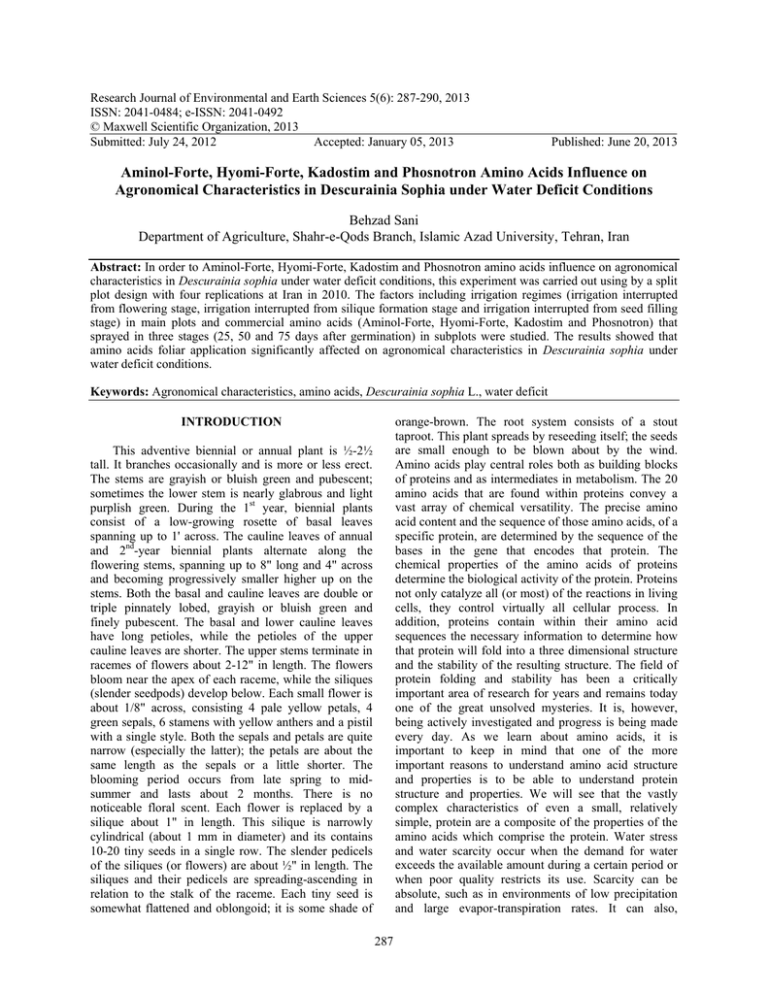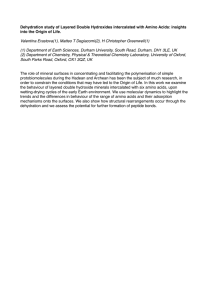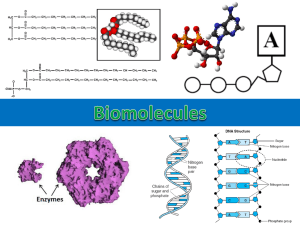Research Journal of Environmental and Earth Sciences 5(6): 287-290, 2013
advertisement

Research Journal of Environmental and Earth Sciences 5(6): 287-290, 2013 ISSN: 2041-0484; e-ISSN: 2041-0492 © Maxwell Scientific Organization, 2013 Submitted: July 24, 2012 Accepted: January 05, 2013 Published: June 20, 2013 Aminol-Forte, Hyomi-Forte, Kadostim and Phosnotron Amino Acids Influence on Agronomical Characteristics in Descurainia Sophia under Water Deficit Conditions Behzad Sani Department of Agriculture, Shahr-e-Qods Branch, Islamic Azad University, Tehran, Iran Abstract: In order to Aminol-Forte, Hyomi-Forte, Kadostim and Phosnotron amino acids influence on agronomical characteristics in Descurainia sophia under water deficit conditions, this experiment was carried out using by a split plot design with four replications at Iran in 2010. The factors including irrigation regimes (irrigation interrupted from flowering stage, irrigation interrupted from silique formation stage and irrigation interrupted from seed filling stage) in main plots and commercial amino acids (Aminol-Forte, Hyomi-Forte, Kadostim and Phosnotron) that sprayed in three stages (25, 50 and 75 days after germination) in subplots were studied. The results showed that amino acids foliar application significantly affected on agronomical characteristics in Descurainia sophia under water deficit conditions. 4T 4T 4T 4T 4T 4T 4T 4T Keywords: Agronomical characteristics, amino acids, Descurainia sophia L., water deficit orange-brown. The root system consists of a stout taproot. This plant spreads by reseeding itself; the seeds are small enough to be blown about by the wind. Amino acids play central roles both as building blocks of proteins and as intermediates in metabolism. The 20 amino acids that are found within proteins convey a vast array of chemical versatility. The precise amino acid content and the sequence of those amino acids, of a specific protein, are determined by the sequence of the bases in the gene that encodes that protein. The chemical properties of the amino acids of proteins determine the biological activity of the protein. Proteins not only catalyze all (or most) of the reactions in living cells, they control virtually all cellular process. In addition, proteins contain within their amino acid sequences the necessary information to determine how that protein will fold into a three dimensional structure and the stability of the resulting structure. The field of protein folding and stability has been a critically important area of research for years and remains today one of the great unsolved mysteries. It is, however, being actively investigated and progress is being made every day. As we learn about amino acids, it is important to keep in mind that one of the more important reasons to understand amino acid structure and properties is to be able to understand protein structure and properties. We will see that the vastly complex characteristics of even a small, relatively simple, protein are a composite of the properties of the amino acids which comprise the protein. Water stress and water scarcity occur when the demand for water exceeds the available amount during a certain period or when poor quality restricts its use. Scarcity can be absolute, such as in environments of low precipitation and large evapor-transpiration rates. It can also, INTRODUCTION This adventive biennial or annual plant is ½-2½ tall. It branches occasionally and is more or less erect. The stems are grayish or bluish green and pubescent; sometimes the lower stem is nearly glabrous and light purplish green. During the 1st year, biennial plants consist of a low-growing rosette of basal leaves spanning up to 1' across. The cauline leaves of annual and 2nd-year biennial plants alternate along the flowering stems, spanning up to 8" long and 4" across and becoming progressively smaller higher up on the stems. Both the basal and cauline leaves are double or triple pinnately lobed, grayish or bluish green and finely pubescent. The basal and lower cauline leaves have long petioles, while the petioles of the upper cauline leaves are shorter. The upper stems terminate in racemes of flowers about 2-12" in length. The flowers bloom near the apex of each raceme, while the siliques (slender seedpods) develop below. Each small flower is about 1/8" across, consisting 4 pale yellow petals, 4 green sepals, 6 stamens with yellow anthers and a pistil with a single style. Both the sepals and petals are quite narrow (especially the latter); the petals are about the same length as the sepals or a little shorter. The blooming period occurs from late spring to midsummer and lasts about 2 months. There is no noticeable floral scent. Each flower is replaced by a silique about 1" in length. This silique is narrowly cylindrical (about 1 mm in diameter) and its contains 10-20 tiny seeds in a single row. The slender pedicels of the siliques (or flowers) are about ½" in length. The siliques and their pedicels are spreading-ascending in relation to the stalk of the raceme. Each tiny seed is somewhat flattened and oblongoid; it is some shade of P P P P 287 Res. J. Environ. Earth Sci., 5(6): 287-290, 2013 Table 1: The results of soil analysis Soil texture Sand (%) Silt (%) Ca.L 35 30 Clay (%) 35 K (mg/kg) 142.2 P (mg/kg) 5.2 N (mg/kg) 38.7 Na (Ds/m) 0.05 EC (1: 2.5) 0.18 pH 7.9 Depth of sampling 0-30 cm Table 2: Analysis of variance Sources of variation Replication Amino acids Water stress Amino acids×water stress Error CV (%) M.S. ---------------------------------------------------------------------------------------------------------------------------------------------------------Biological yield Seed yield Stem dry weight Silique dry weight Essential oil yield Leaf dry weight Plant height 0.007 15.931** 151.124** 189143.313 0.005 5.414** 0.084** 1.423** 10.087** 112.006** 1520201.243** 0.071** 41.633** 0.041** 1.515** 11.797** 169.053** 1089514.354** 0.058** 67.903** 0.022** 0.027 0.008 0.961 211820.317* 0.056 0.267 0.004 0.009 0.032 2.608 86199.201 0.003 1.541 0.002 6.920 4.540 6.990 8.220 2.770 9.640 8.080 df 2 1 3 3 18 *: Significant at 5% level; **: Significant at 1% level; M.S.: Mean square however, be induced by economic or political constraints, which do not permit the adequate development of water resources. Critical conditions often arise for economically poor and politically weak communities living in already dry environments. The Unitied Nations' FAO states that by 2025, 1.8 billion people will be living in countries or regions with absolute water scarcity and two-thirds of the world population could be under stress conditions. The total amount of available freshwater supply is decreasing because of climate change, which has caused receding glaciers, reduced stream and river flow and shrinking lakes. Many aquifers have been over-pumped and are not recharging quickly. Although the total fresh water supply is not used up, much has become polluted, salted, unsuitable or otherwise unavailable for drinking, industry and agriculture. A country or region is said to experience "water stress" when annual water supplies drop below 1,700 m3/person/year, according to the Falkenmark Water Stress Indicator. At levels between 1,700 and 1,000 m3/person/year, periodic or limited water shortages can be expected. When water supplies drop below 1,000 m3/person/year, the country faces water scarcity (Abdul-Jaleel et al., 2007; Chen, 2006; Deka et al., 1992; Dixon and Kahn, 2004; Mandal et al., 2007; Vessey, 2003; Wu et al., 2005; Zhao et al., 2005). Therefore, the objective of this study was to evaluate the effects of Aminol-Forte, Hyomi-Forte, Kadostim and Phosnotron amino acids and water stress on quantity and quality features in flixweld (Descurainia sophia L.). 7T 4T 4T 7T 7T 7T 7T P P Data were subjected to Analysis of Variance (ANOVA) using Statistical Analysis System (SAS Institute, 1988) and followed by Duncan's multiple range tests. Terms were considered significant at (p<0.05). P 4T 4T 4T RESULTS Final results of plants values showed that amino acids significantly affected plant characteristics in p≤0.01 (Table 2) which indicated the highest biological yield (9206 kg/ha), seed yield (1815 kg/ha), stem dry weight (3728 kg/ha), silique dry weight (305.2 kg/ha), leaf dry weight (3476 kg/ha), essential oil yield (17.5 kg/ha) and plant height (84 cm) were obtained by Kadostim application. Also, water stress significantly affected all features in p≤0.01 (Table 2). The highest biological yield (10080 kg/ha), seed yield (2279 kg/ha), stem dry weight (4231 kg/ha), silique dry weight (363.5 kg/ha), essential oil yield (20.1 kg/ha), leaf dry weight (1714 kg/ha) and plant height (82 cm) were achieved by normal irrigation. Interaction of the amino acids and water stress had significant effect on silique dry weight in p<0.05 (Table 2) and highest biological yield (9643 kg/ha), seed yield (2047 kg/ha), stem dry weight (3979 4T MATERIALS AND METHODS This study was conducted on experimental field of Islamic Azad University, Shahr-e-Qods Branch at Iran (27°38' N, 40°21' E; 1417 m above sea level) during 2010, with clay loam soil (Table 1), mean annual temperature (31°C) and rainfall in the study area is distributed with an annual mean of 215 mm. The experimental unit had designed by achieved treatments in factorial on the basis completely randomized block design with three replicates. Certain factors including irrigation regimes (irrigation interrupted from flowering P P P 1T 1T P Essential oil yield = Essential oil percentage × Seed yield P P 4T 7T 7T P 4T P 7T 7T 7T stage, irrigation interrupted from silique formation stage and irrigation interrupted from seed filling stage) in main plots and commercial amino acids (AminolForte, Hyomi-Forte, Kadostim and Phosnotron) that sprayed in three stages (25, 50 and 75 days after germination) in subplots were studied. The soil consisted of 25% clay, 30% silt and 45% sand (Table 1) and further the field was prepared in a 15 m2 area (5×3 m). At the end of growth stage we collected 10 plants from each plot randomly for determination of plant characteristics andselected 100 g seed from each plot for determination of essential oil percentage by Clevenger. Finally, essential oil yield was determined by the following formula (Aliabadi, 2006): P 1T 1T 288 Res. J. Environ. Earth Sci., 5(6): 287-290, 2013 kg/ha), silique dry weight (334.3 kg/ha), essential oil yield (18.8 kg/ha), leaf dry weight (1595 kg/ha) and plant height (103 cm) were obtained under application of kadostim and normal irrigation. and concern on fertilizer strategy and carefully estimate chemical fertilizer supply by amino acids application. DISCUSSION Abdul-Jaleel, C., P. Manivannan, B. Sankar, A. Kishorekumar, R. Gopi, R. Somasundaram and R. Panneerselvam, 2007. Pseudomonas fluorescens enhances biomass yield and ajmalicine production in Catharanthus roseus under water deficit stress. Colloids Surf. B Biointerf., 60: 7-11. Aliabadi, F.H., 2006. Investigation of Arbuscular Mycorrhizal Fungi (AMF), different levels of phosphorus and drought stress effects on quantity and quality characteristics of coriander (Coriandrum sativum L.). M.Sc. Thesis, Department of Agriculture, Takestan Branch, Islamic Azad University, Qazvin, Iran, pp: 231. Chen, J., 2006. The combined use of chemical and organic fertilizers and/or biofetilizer for crop growth and soil fertility. International Workshop on Sustained Management of the Soil-Rhizosphere System for Efficient Crop Production and Fertilizer Use, October, Thailand, pp: 16-20. Deka, B.C., G.C. Bora and A. Shadeque, 1992. Effect of Azospirillum on growth and yield of chilli (Capsicum annuum L.) cultivar Pusa Jawala, Haryana. J. Hort. Sci., 38: 41-46. Dixon, R. and D. Kahn, 2004. Genetic regulation of biological nitrogen fixation. Nat. Rev. Microbiol., 2(8): 621-31. Knowles, T.C., B.W. Hipp, P.S. Graff and D.S. Marshall, 1994. Timing and rate of topdress nitrogen for rainfed winter wheat. J. Prod. Agric., 7: 216-220. Mandal, A., A.K. Patra, D. Singh, A. Swarup and M.R. Ebhin, 2007. Effect of long-term application of manure and fertilizer on biological and biochemical activities in soil during crop development stages. Biores. Technol., 98: 3585-3592. Migahed, H.A., A.E. Ahmed and B.F. Abd El-Ghany, 2004. Effect of different bacteial strains as biofertilizer agents on growth, production and oil of Apium graveolense under Calcareous soil. J. Agric. Sci., 12: 511-525. Ratti, N., S. Kumar, H.N. Verma and S.P. Gautams, 2001. Improvement in bioavailability of tricalcium phosphate to Cymbopogon martini var. motia by rhizobacteria, AMF and Azospirillum inoculation. Microb. Res., 156: 145-149. SAS Institute, 1988. Statistics Analysis System User's Guide: Statistics. SAS Institute Cary, NC. Stark, J.C. and T.A. Tindall, 1992. Timing split applications of nitrogen for irrigated hard red spring wheat. J. Prod. Agric., 5: 221-226. REFERENCES In this study, increases in agronomic criteria were observed following inoculation with amino acids. This may be due to better utilization of nutrients in the soil through inoculation of efficient microorganisms. A positive effect of amino acids on yield and yield components has been reported in the literature (Migahed et al., 2004). In addition, higher dry matter production by the inoculated plant might be because of the augmented uptake of N which in turn was a consequence of the root proliferation. Also, the increased growth parameters in hyssop might be due to the production of growth hormones by the bacteria (Ratti et al., 2001). The results showed that application of amino acids and normal irrigation increased yield and yield components of flixweld, because amino acids is a primary constituent of proteins, is extremely susceptible to loss when considering that average recovery rates fall in the range of 20 to 50% for dry matter production systems in plants. Amino acids generally because deficiency of potassium increased carbohydrate storage and reduced proteins, alteration in amino acid balance and consequently change in the quality of proteins and are a main element in chlorophyll production. Toxic concentrations of amino acids fertilizers cause characteristic symptoms of nitrite or nitrate toxicity in plants, particularly in the leaves. Although pre plant fertilizer applications decrease the potential for nutrient deficiencies in early stages of growth, presence of residual soil NO 3 -N (plantavailable mineral amino acids from the previous season) may pose a risk to the environment. The water of soil be salt by inordinate amino acids application and increase its potential. Finally, the plant use high energy for absorb of salt water that be causes dry matter reduces in this condition. Therefore, dry matter reduced under application of chemical fertilizer application because injured roots and was reduced the absorption. Our results were similar to the findings of Stark and Tindall (1992), Wuest and Cassman (1992) and Knowles et al. (1994). CONCLUSION In general it appears that, as expected, application of amino acids improved yield and other plant criteria. Therefore, it appears that application of amino acids could be promising in production of flixweld by reduction of chemical fertilizer application. Our finding may give applicable advice to farmers for management 289 Res. J. Environ. Earth Sci., 5(6): 287-290, 2013 Vessey, J.K., 2003. Plant growth promoting rhizobacteria as biofertilizers. Plant Soil, 255: 571-586. Wu, S.C., Z.H. Caob, Z.G. Lib, K.C. Cheung and M.H. Wong, 2005. Effects of biofertilizer containing N-fixer, P and K solubilizers and AM fungi on maize growth: A greenhouse trial. Geoderma, 125: 155-166. Wuest, S.B. and K.G. Cassman, 1992. Fertilizernitrogen use efficiency of irrigated wheat: I. Uptake efficiency of preplant versus late-season application. Agron. J., 84: 682-688. Zhao, J., T. Lawrence, C. Davis and R. Verpoorte, 2005. Elicitor signal transduction leading to production of plant secondary metabolites. Biotechnol. Adv., 23: 283-333. 290




